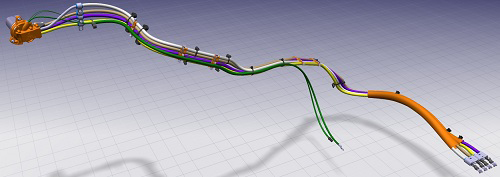Tesla Model S: HV Harness - HVJB to Charge Port - 2nd Generation
Warning: Only technicians who have been trained in High Voltage Awareness are permitted to perform this procedure. Proper personal protective equipment (PPE) and insulating HV gloves with a minimum rating of class 00 (500V) must be worn any time a high voltage cable is handled. Refer to Tech Note TN-15-92-003, "High Voltage Awareness Care Points" for additional safety information. Removal
- Perform the vehicle electrical isolation procedure (refer to procedure).
- Remove the 2nd row seat cushion frame (refer to procedure).
- Remove the LH C-Pillar lower trim panel (refer to procedure).
- Remove the LH trunk trim (refer to procedure).
- Remove the high voltage junction box (HVJB) cover (refer to procedure).
- Starting from the front and working toward the rear of the
vehicle, mark the 4 HV cables that lead to the charge port from
front to rear as L2, L3, L1, and N.

- Release the 4 bolts inside the HVJB that secure the HV cables that lead to the charge port (torque 4 Nm). Note: It is not necessary to replace the fastener(s) after it is removed. The threaded area has a reusable dry sealant, which looks similar to adhesive patch material.
- Release the nut that secures the grounding wire from the charge
port (torque 6 Nm).

- Disconnect the proximity detection harness.

- Remove the grounding bracket by releasing the nut that secures
it to the body.
- Single phase (North America, Japan): torque 6 Nm
- 3 phase (Europe, APAC): torque 9 Nm

- Remove the cover from the cable connector by using a trim tool
or similar non-conductive tool to bend the 3 tabs that secure the
cover to the cable connector.
Note: The locations of the tabs are marked by arrows on the face of the cover.
Caution: Do not lose or damage the magnet on the outboard side of the cable connector.

- Remove the 3 bolts that secure the cable connector to the charge
port in the order shown. Remove the cable connector from the charge
port.
- Single phase (North America, Japan): torque 4 Nm
- 3 phase (Europe, APAC): torque 5 Nm

Note: Before performing the next step, note the locations of the clips that secure the HV harness to the 2nd row seat frame. During installation of the new HV harness, ensure that the harness is clipped to the seat frame in the same locations.
- Release the clips that secure the HV cables to the 2nd row seat frame.
- Release the cable tie mounts that secure the harness to the
studs on the body.

- Remove the harness assembly from the vehicle.

Installation procedure is the reverse of removal, except for the following:
- Ensure that the harness is clipped to the second row seat frame.
- When securing the cable connector to the charge port, tighten the bolts in the reverse order of removal.
- When securing the HVJB lid, first hand-tighten the HVIL bolt. Then, fully tighten the 5 nuts and 1 bolt in the reverse order of removal. Finally, fully tighten the HVIL bolt.

